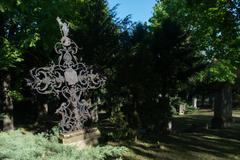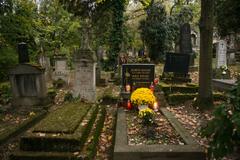When sightseeing foreign cities some people visit local cemeteries, either to show respect to buried personalities buried or learn more about the locals. This is because cemeteries speak about their culture and how they see the world more than streets or squares.

One cemetery worth visiting in Bratislava is the Vrakuňa Cemetary. It is one of the newest cemeteries and unlike other Bratislava cemeteries, it has a remarkable architectural concept. Its author, architect Kamil Čečetka, did not only arrange graves into circular sections, but the shape of tombstones was prescribed until 1997.
“The architect Čečetka designed it with his co-workers as a turnkey project,” said Ivor Švihran, who organises untraditional tours of Bratislava.
The creation
The original Ružinov Cemetary, which was renamed in 2013 to Vrakuňa Cemetary in order for its name to better reflect its location, spreads out over a former field on the edge of the Vrakuňa borough. It is 15.5 hectares when the original plan was to extend it in several phases to about 30 hectares. These plans did not materialise.
Čečetka concentrated the graves into circles interconnected with freely flowing paths. The graves are arranged either in parallel rows, in circles or wavy lines making the circles differ from each other. Surviving relatives could have selected from more than 10 types of tombstones designed by the sculptor Alexander Bilkovič.

These used to stay on a meadow within the cemetery as a kind of a sampler until 2016. Since Bratislava is running out of burial space, they were removed to make space for new graves.
“Probably most of the standardised tombstones can still be seen in the Section I, where the oldest graves are,” said Švihran.
Since people did not like the requirement of selecting the tombstone shapes from the standardised, it was scrapped in 1997.
“The result can be seen in the section at the far end of the cemetery,” said Švihran. “It is the selection of the worst burial kitsch. There was not even space left for tree alleys and the paths between graves were narrowed to a minimum.”
The house of mourning with the ceremonial hall was designed by Čečetka, while the designer Vojtech Vilhan and architect Ján Bahna are the creators of its interior.



 Vrakuňa Cemetery in Bratislava (source: Jana Liptáková)
Vrakuňa Cemetery in Bratislava (source: Jana Liptáková)
 Most graves with standardised tombstones can still be seen in the Section I (source: Jna Liptáková)
Most graves with standardised tombstones can still be seen in the Section I (source: Jna Liptáková)
 (source: Jana Liptáková)
(source: Jana Liptáková)